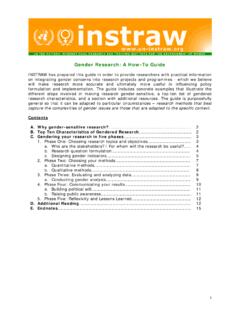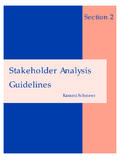Transcription of Summary of the Framework for Program Evaluation
1 CDC Evaluation WORKING GROUP Revision: August 14, 1999 Summary of the Framework for Program Evaluation1 Citation: Centers for Disease Control and Prevention. Framework for Program Evaluation in public health. MMWR 1999;48( ):1-42. 1. Summary Effective Program Evaluation is a systematic way to improve and account for Program actions involving methods that are useful, feasible, ethical, and accurate. The Framework is a practical, nonprescriptive tool, designed to summarize and organize essential elements of Program Evaluation . The Framework comprises steps in Evaluation practice and standards for effective Evaluation . Adhering to these steps and standards will allow an understanding of each Program 's context and will improve how evaluations are conceived and conducted. The Framework inherently maximizes payoffs and minimizes costs because it is a template for designing optimal, context-sensitive evaluations. 2. How to Assign Value Assigning value and making judgments regarding a Program on the basis of evidence requires answering the following questions: What will be evaluated?
2 ( what is "the Program " and in what context does it exist) What aspects of the Program will be considered when judging Program performance? What standards must be reached for the Program to be considered successful? What evidence will be used to indicate how the Program has performed? What conclusions regarding Program performance are justified by comparing the available evidence to the selected standards? How will lessons learned from the inquiry be used to improve Program effectiveness? These questions should be addressed at the beginning of a Program and revisited throughout its implementation. The Framework provides a systematic approach for answering these questions. This is a condensed version of a longer description of the Framework . The full version has 112 references which show the depth of research and theory upon which the Framework rests. Due to space limitations, these references have been removed. Also, the term " Program " is used to describe the object of Evaluation ; it applies to any organized action to achieve a desired end.
3 This definition is deliberately broad because the Framework can be applied to almost any Program activity. L:\CDC\Eval Group\ Framework Printed/Revised: September 13, 1999 1 Summary of the Framework Page 2 3. Framework for Program Evaluation The Framework comprises steps in Evaluation practice and standards for effective Evaluation (Figure 1). There are several subpoints to address when completing each step, all of which are governed by the standards for effective Program Evaluation (Box 1). Thus, the steps and standards are used together throughout the Evaluation process. For each step there are a sub-set of standards that are generally most relevant to consider (Box 2). 4. Steps in Evaluation Practice The six connected steps of the Framework provide a starting point to tailor an Evaluation for a particular Program , at a particular point in time. The steps are all interdependent and might be encountered in a nonlinear sequence; however, an order exists for fulfilling each earlier steps provide the foundation for subsequent progress.
4 Thus, decisions regarding how to execute a step are iterative and should not be finalized until previous steps have been thoroughly addressed. The steps are as follows: Engage stakeholders Describe the Program Focus the Evaluation design Gather credible evidence Justify conclusions Ensure use and share lessons learned a. Engaging Stakeholders (Box 3) The Evaluation cycle begins by engaging stakeholders ( , the persons or organizations having an investment in what will be learned from an Evaluation and what will be done with the knowledge). Almost all Program work involves partnerships; therefore, any assessment of a Program requires considering the value systems of the partners. Stakeholders must be engaged in the inquiry to ensure that their perspectives are understood. When stakeholders are not engaged, Evaluation findings might be ignored, criticized, or resisted because they do not address the stakeholders questions or values. After becoming involved, stakeholders help to execute the other steps.
5 Identifying and engaging the following three principle groups are critical: Those involved in Program operations ( , sponsors, collaborators, coalition partners, funding officials, administrators, managers, and staff) Those served or affected by the Program ( , clients, family members, neighborhood organizations, academic institutions, elected officials, advocacy groups, professional associations, skeptics, opponents, and staff of related or competing agencies) Primary users of the Evaluation ( , the specific persons in a position to do or decide something regarding the Program ) Summary of the Framework Page 3 b. Describe the Program (Box 4) Program descriptions set the frame of reference for all subsequent decisions in an Evaluation . The description enables comparisons with similar programs and facilitates attempts to connect Program components to their effects. Moreover, stakeholders might have differing ideas regarding Program goals and purposes. Evaluations done without agreement on the Program definition are likely to be of limited use.
6 Sometimes, negotiating with stakeholders to formulate a clear and logical description will bring benefits before data are available to evaluate Program effectiveness. Aspects to include in a Program description are: Need What problem or opportunity does the Program addresses? Who experiences it? Expected effects What changes resulting from the Program are anticipated? What must the Program accomplish to be considered successful? Activities What steps, strategies, or actions does the Program take to effect change? Resources What assets are available to conduct Program activities ( , time, talent, technology, information, money, etc.)? Stage of development How mature is the Program ( , is the Program mainly engaged in planning, implementation, or effects)?2 Context What is the operating environment around the Program ? How might environmental influences ( , history, geography, politics, social and economic conditions, secular trends, efforts of related or competing organizations) affect the Program and its Evaluation ?
7 Logic model What is the hypothesized sequence of events for bringing about change? How do Program elements connect with one another to form a plausible picture of how the Program is supposed to work? During planning, Program activities are untested, and the goal of Evaluation is to refine plans. During implementation, Program activities are being field-tested and modified; the goal of Evaluation is to characterize real, as opposed to ideal, Program activities and to improve operations, perhaps by revising plans. During the last stage, enough time has passed for the Program s effects to emerge; the goal of Evaluation is to identify and account for both intended and unintended effects. 2 Summary of the Framework Page 4 c. Focus the Evaluation Design (Box 5) The direction and process of the Evaluation must be focused to assess issues of greatest concern to stakeholders while using time and resources as efficiently as possible. Not all design options are equally well-suited to meeting the information needs of stakeholders.
8 After data collection begins, changing procedures might be difficult or impossible, even if better methods become obvious. A thorough plan anticipates intended uses and creates an Evaluation strategy with the greatest chance of being useful, feasible, ethical, and accurate. Among the items to consider when focusing an Evaluation are the following: Purpose: What is the intent or motive for conducting the Evaluation ( , to gain insight, change practice, assess effects, or affect participants)? Users Who are the specific persons that will receive Evaluation findings or benefit from being part of the Evaluation ? Uses How will each user apply the information or experiences generated from the Evaluation ? Questions What questions should the Evaluation answer? What boundaries will be established to create a viable focus for the Evaluation ? What unit of analysis is appropriate ( , a system of related programs , a single Program , a project within a Program , a subcomponent or process within a project)?
9 Methods What procedures will provide the appropriate information to address stakeholders questions ( , what research designs and data collection procedures best match the primary users, uses, and questions)? Is it possible to mix methods to overcome the limitations of any single approach? Agreements How will the Evaluation plan be implemented within available resources? What roles and responsibilities have the stakeholders accepted? What safeguards are in place to ensure that standards are met, especially those for protecting human subjects? Summary of the Framework Page 5 d. Gather Credible Evidence (Box 6) Persons involved in an Evaluation should strive to collect information that will convey a well-rounded picture of the Program and be seen as credible by the Evaluation s primary users. Information should be perceived by stakeholders as believable and relevant for answering their questions. Such decisions depend on the Evaluation questions being posed and the motives for asking them.
10 Having credible evidence strengthens Evaluation judgments and the recommendations that follow from them. Although all types of data have limitations, an Evaluation s overall credibility can be improved by using multiple procedures for gathering, analyzing , and interpreting data. When stakeholders are involved in defining and gathering data that they find credible, they will be more likely to accept the Evaluation s conclusions and to act on its recommendations. The following aspects of evidence gathering typically affect perceptions of credibility: Indicators How will general concepts regarding the Program , its context, and its expected effects be translated into specific measures that can be interpreted? Will the chosen indicators provide systematic data that is valid and reliable for the intended uses? Sources What sources ( , persons, documents, observations) will be accessed to gather evidence? What will be done to integrate multiple sources, especially those that provide data in narrative form and those that are numeric?















